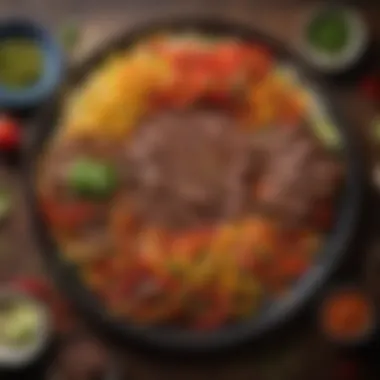Transforming Leftover Steak into Culinary Delights


Intro
Transforming leftover steak into a dish that pleases the palate can be a thrilling culinary challenge. Often, people simply reheat their leftovers out of convenience and miss the chance to create something unique. The objective here is to provide a detailed framework for cooking enthusiasts eager to elevate their leftover steak from a mere side note to a celebrated ingredient. This article dives into with an array of innovative approaches, appealing to both novice cooks and seasoned chefs alike.
Ingredients Breakdown
Primary Ingredients
- Leftover steak (grilled, roasted or pan-seared)
- Vegetables such as bell peppers, onions, and mushrooms
- Aromatic herbs like thyme and rosemary
- Broth or sauce (beef stock, soy sauce, or barbecue sauce)
Optional Ingredients
- Cheese (Parmesan or cheddar)
- Pasta or rice
- Marinades and rubs for additional flavor
Essential Kitchen Tools
- Chef's knife for chopping ingredients
- Cutting board for safety
- Skillet or frying pan for cooking methods
- Storage containers for leftovers
Step-by-Step Preparation
Prepping the Ingredients
Begin by examining your leftover steak. Remove any unwanted fat and cut it into even chunks or slices, ensuring even cooking when you heat or incorporate it into another dish. It’s essential to let the meat come to room temperature if possible. This brief rest will enhance the final dish's flavor profile.
Cooking Techniques and Methods
You can approach leftover steak in diverse ways. Options range from stir-frying and sautéing to stewing.
- Stir-fry: Quickly combine chopped steak with vegetables in a hot pan, tossing continuously. This keeps the steak juicy and colorful.
- Sauté: For dishes needing a more substantial treatment, sauté the steak in a bit of oil along with aromatics until flavors have meld.
- Stewing: For a cozy dish, consider a low and slow method. Combine the steak with broth and chopped vegetables, simmer until tender.
Assembly and Presentation Tips
Garnishing your dish can enhance visual appeal. For example, chopped fresh herbs can provide a contrast against warm, earthy tones from the meat and veggies. Provide portions in attractive bowls or plates for a professional-looking presentation.
Dietary Considerations
Gluten-Free Options
For those adhering to a gluten-free diet, choosing sauces, stocks, and condiments that do not contain gluten is crucial. Ingredients like tamari can serve as gluten-free alternatives to soy sauce.
Vegetarian and Vegan Substitutes
Vegetables, grains, or tofu can provide ample substitutes depending on the dish. Adjust recipes to replace steak with these options to cater to various dietary preferences.
Nutrition Facts & Nutritional Considerations
- Steak is protein-rich but can also contain high levels of saturated fat. Incorporating vegetables can balance the dish nutritionally, enhancing fiber and vitamin intake.
Variations and Customizations
Flavor Enhancements
For an upgraded profile, consider adding spices such as cayenne or smoked paprika. Using bold marinades can also deepen flavor and create diverse dishes.
Alternative Cooking Methods
Other techniques might include grilling, using an air fryer, or preparing the steak with sous-vide for precision temperature control and tenderness.
Pairing Suggestions (Sides, Drinks, etc.
)
Complement your repurposed steak dish with sides like roasted potatoes, grilled seasonal veggies, or artisan bread. Beverage pairings can range from a rich red wine to a refreshing craft beer, enhancing the dining experience.
Common Questions and Answerss and Troubleshooting
Frequently Asked Questions


- Can I freeze leftover steak? Yes, ensure it is well-wrapped to avoid freezer burn.
- How can I prevent leftover steak from becoming tough? Reheat gently using low heat, ideally with moisture.
Common Mistakes to Avoid
Avoiding overcooking is crucial. Resist high heat for reheating lean cuts; they tend to dry out easily.
Solutions to Potential Problems
If you encounter dryness, a splash of broth can restore moisture while heating on the stove.
Making a conscious effort to use leftover steak creatively not only reduces food waste but also surprises the senses with new flavors.
Preface to Leftover Steak
Leftover steak often faces a fate of being forgotten in the fridge, yet it holds untapped potential for culinary creativity. Understanding how to maximize the value of leftover steak ensures flavorful meals and contributes to reducing food waste, a concern for many home cooks today. Repurposing this meat can provide both convenience and variety in meal planning.
Understanding the Value of Leftover Steak
Leftover steak is not merely scrap; it possesses remarkable versatility and rich flavor that can enhance various dishes. Incorporating leftover steak saves both time and resources, as one can create multiple meals from a single cooking endeavor. Steak can be incorporated into salads, tacos, sandwiches, or stir-fries, demonstrating its adaptability.
Moreover, the second-hand context often imbues steak with more texture and taste once it has been marinated or seasoned and left to sit. This can surprise even seasoned cooks who may have dismissed leftovers as uninspiring. Therefore, recognizing the inherent value of leftover steak can transform one's cooking experience from mundane to innovative.
- By valuing leftover steak, you can diversify your meals.
- Repurposing encourages sustainable practices, minimizing what goes to waste.
- Find new flavors with reheating techniques that elevate the dish.
Common Mistakes in Storing Leftover Steak
How we store leftover steak often determines its quality on reuse. Despite best intentions, common mistakes can spoil otherwise good protein. A significant error arises when steak is placed in the fridge without adequate preparation. Failing to wrap the meat securely can expose it to contaminants, altering flavor and increasing spoilage risk.
Another frequent pitfall is neglecting to label and date leftover steak before refrigeration. Without this, it can be easy to forget its existence, leaving it abandoned for who knows how long. The freshest tastes stem from FDA guidelines, which generally recommend consuming cooked meat within three to four days.
To store leftover steak correctly:
- Use airtight containers or aluminum foil to prevent exposure to air.
- Date and label to track how long it has been stored in the refrigerator.
- Avoid cutting or slicing before storing; this keeps the meat moister when reheating later.
Remember: Proper storage techniques not only protect flavor but also ensure safety when you later mix leftover steak into delicious new dishes.
Preparing Leftover Steak for Reuse
Preparing leftover steak for reuse is a critical focus in this article. Understanding how to properly handle and repurpose steak promotes not only optimal flavor but also ensures food safety. Many people overlook the potential of leftover steak, often resorting to mundane reheating methods that can lead to dry and unappetizing results. Instead, with a thoughtful approach to preparation, leftover steak can be transformed into a variety of culinary delights. This section will discuss essential reheating practices and safety tips that are invaluable for both novice and experienced cooks.
Best Practices for Reheating
Reheating steak correctly can make significant difference in its overall texture and flavor. Here are some best practices to ensure your steak remains tender and juicy:
- Use a Low Temperature: Reheating at lower temperatures helps to preserve moisture within the meat. It could be done either in an oven or on a stovetop, typically around 250°F (121°C).
- Add Moisture: Incorporating a splash of beef broth or a pat of butter can contribute to a more enjoyable result. This method brings some of the original flavors back.
- Cover the Steak: Wrapping the steak in aluminum foil or placing it in a covered dish traps heat and moisture. This prevents the meat from drying out.
- Check Temperature: Use a meat thermometer for precise reheating. The internal temperature should ideally reach 130°F to 140°F (54°C to 60°C) for best results.
- Avoid Microwaving: While fast, microwaves tend to alter the texture of steak, often resulting in a rubbery consistency. If microwaving is the only option, use low power settings for shorter intervals.
Reheating steak with care guarantees a flavorful dish instead of a compromise.
Now, let’s focus on the important aspect of food safety when handling leftover steak.
Safety Tips for Handling Leftover Meat
When it comes to casting aside the narrative of waste and focusing on innovative culinary uses, safety considerations must come first. The FDA offers basic guidance for storing and handling meat, including:
- Storage Time: Leftover steak should ideally be consumed within three to four days. After this timeframe, the risk of foodborne illness increases.
- Proper Cooling: Leftover steak should cool to room temperature and then be stored in the refrigerator within two hours of cooking. Cool faster by placing it in an airtight container or shallow dish.
- Temperature Control: Always store leftover steak at 40°F (4°C) or colder to keep bacteria from growing. Reheating should return the meat to safe levels, as noted earlier.
- Avoid Cross-Contamination: Ensure that cooking tools, containers, and surfces are clean both before and after handling leftovers. Wash kitchen utensils and hands thoroughly.
- Freezing for Later Use: If unsure of consuming the steak within a few days, freezing can be a suitable option. Wrap it tightly to avoid freezer burn and label it with the date before freezing.
These practices not only protect health but also maintain the flavor and enjoyment of leftover steak, opening doors to numerous delicious reinventions. By valuing proper preparation, one can turn leftover steak into enticing meals rather than merely a matter of avoiding wastage.
Creative Dishes Featuring Leftover Steak
Utilizing leftover steak can drastically expand culinary creativity, bringing freshness into meal preparation. Leftover steak does not have to be just reheated and served alongside basic sides. Instead, with a bit of imagination, it can be transformed into exciting new dishes that captivate the palate. These creative approaches not only make meals enjoyable, but also ensure that no flavorful meat goes to waste, making them a practical kitchen strategy.
Steak Tacos: A Quick and Flavorful Option
Steak tacos offer a straightforward yet delicious way to repurpose leftover steak. To start off, slice the steak thinly against the grain. This helps to maintain tenderness and enhances flavor release. Warm up small tortillas—either corn or flour work great—and fill them accordingly. Add fresh toppings such as diced onions, chopped cilantro, avocado, or a sprinkle of lime juice. A dash of salsa adds a further punch. This method preserves the steak's essence while introducing vibrant textures and tastes.
Benefits of Steak Tacos:
- Fast preparation: Typically, it takes only 15 minutes.
- Uses minimal additional ingredients, keeping both time and effort low.
- Customizable: Offers a variety of toppings to suit individual preferences.


Steak Salad: A Nourishing Meal
For a more health-centered take, steak salad speaks volumes. Start with a base of mixed greens, such as spinach, arugula, or romaine. Incorporating colorful ingredients like cherry tomatoes, cucumbers, and bell peppers makes this dish not just eye-catching but also nutritious. Top the salad with sliced leftover steak, and drizzle on a light vinaigrette. The freshness of vegetables balances the savory depth of the steak, creating a nourishing meal suitable for any time of the day.
Considerations for Crafting Steak Salad:
- Use different greens to prevent monotony in flavors.
- Incorporate nuts or seeds for added texture.
- Opt for micro herbs for advanced flavor dimensions.
Steak Stir-Fry: Fast and Versatile
Stir-frying showcases versatility with leftover steak. Briefly reheating slices in a hot pan while adding vegetables elevates the dish quickly and efficiently. Common choices, including broccoli, bell peppers, and snap peas, maintain their crunch when cooked briefly. Soy sauce or teriyaki sauce enriches the flavor, creating a stunning plate served over rice or noodles. This express method efficiently uses what you have, ensuring that every component shines in flavor.
Efficiency of Stir-Frying:
- Reduces cooking time significantly.
- Great way to incorporate various vegetables into a meal.
- Encourages appreciation of diverse textures and tastes.
Steak Sandwiches: A Satisfying Lunch
Steak sandwiches allow for a comforting repurpose of leftover meat into lunch options. Choose your preferred bread—sub rolls, baguettes, or artisanal loaves work nicely. Warm the steak slices with some cheese, such as provolone or cheddar, giving an indulgent touch. You could also layer charred peppers or caramelized onions to enhance the flavor. Pair the sandwich with a side of crispy fries or a refreshing coleslaw for completion.
Confident Lunch Experience:
- Easy to prepare, perfect for those press for time.
- Offers a filling meal without excessive work.
- Variability of fillings opens doors for creativity.
Steak Fried Rice: A One-Pan Solution
Stir-fried rice is the ultimate one-pan solution to use leftover steak effectively. Begin by moving cold, day-old rice into a hot pan—this integrates flavors better. Toss in the steak alongside vegetables like peas and carrots. To finish, an egg or two helps enrich the dish while combining everything smoothly. This entirely one-pot method condenses effort and clean-up time. Utilizing what’s on hand results in a satisfying meal worthy of any dinner table.
Benefits of Fried Rice:
- Efficiently makes use of various leftovers.
- Quick cooking ensures speedy meal propagation.
- Ideal for feeding family: Heartily packs each serving full of flavor.
Flavor Enhancements for Leftover Steak
Enhancing the flavor of leftover steak is paramount in maximizing taste and enjoyment. By applying marinades, sauces, herbs, and spices, you transform the meager remnants of a previous meal into something vibrant. This section delves into effective enhancements that can elevate your dish while also retaining the charred essence of original preparation. Proper application of these enhancements can ensure that your leftover steak does not go to waste and provides a gratifying culinary experience.
Marinades and Sauces: Elevating the Dish
Marinades can infuse leftover steak with an entirely new identity. By combining oil, acidity, and various flavor components, you create layers of flavor that mitigate any dryness which may have developed after the initial cooking process. Here are a few benefits of using marinades:
- Tenderizes the Meat: The acid in marinades can tenderize tough portions of the steak.
- Creates Layers of Flavor: Each ingredient contributes to a unique flavor that deeply penetrates the meat.
- Customizes the Experience: Various combinations allow personalization, adjusting for taste preferences.
To prepare a marinade, consider a base of olive oil combined with vinegars such as balsamic or red wine. Elements like soy sauce or Worcestershire sauce introduce an umami depth. Adding garlic, and black pepper then adjust to your taste. A good guideline is soaking the steak for at least an hour, though overnight in the refrigerator yields better results.
Sauces also serve as method to maximize flavor without overly altering the original steak. Pair steamed vegetables with rich steak sauces like chimichurri or a red wine reduction for a balance of taste sensations. Applicability extends to versatility in just a few basic sauce recipes, including:
- Red Wine and Shallot Reduction: Distill fine flavor by cooking shallots in red wine until concentrated.
- Honey Mustard: Mix honey, mustard, and olive oil for a sweet and tangy finish.
“A marinade is genuinely transformative, adding complexity that repurposes leftover steak into a delicious dish.”
Herbs and Spices: Adding Depth of Flavor
The inclusion of fresh herbs and spices acts as a dynamic catalyst for revitalizing any leftover steak. The addition of herbs—both dried and fresh—can expand the flavor palate significantly. Some commonly utilized options include:
- Rosemary: This herb imparts a pine-like flavor, pairing well with steak.
- Thyme: Subtle and earthy, thyme brightens the naturally rich profile of steak.
- Parsley: A simple garnish can elevate presentation and flavor simultaneously.
In addition Kamchatka fresh herbs, adjusting your spice utilization is equally critical. Fresh-ground pepper, paprika, or even responsible cayenne pepper contribute needed warmth and pairs exceptionally alongside marinades. When desired, giving a fajita twist through seasoning blends enables easy transition into other cuisines.
- Garlic Powder and Paprika: Together they create satisfying tones that dance through the entire overall flavor.
- Chili Flakes: These stimulate flavor sensations, perfect for a bit of heat.
In summary, the nuanced employment of marinades, sauces, herbs, and spices adds dimensions to leftover steak, ensuring it transcends mere repurposing. Attention to these elements can reestablish delight, posture it as a centerpiece meal rather than simply using the remnants.
Incorporating Leftover Steak into Diverse Cuisines
Incorporating leftover steak into diverse cuisines is a valuable concept in meal preparation. This approach not only reduces food waste but also enhances culinary creativity. Different cultures offer unique flavor profiles, giving home cooks the ability to transform yesterday’s steak into exciting new dishes. By leveraging familiar recipes from various cuisines, individuals can enjoy flavorful meals while maximizing their resources. Understanding these benefits opens doors to innovative ways to consume leftover steak.
Steak in Asian Cuisine
Asian cuisine provides a diverse platform for repurposing leftover steak. Numerous dishes, including stir-fries and salads, easily adapt beef with minimal effort. For instance, a beef stir-fry utilizes tender steak slices that incorporate easily into a mix of colorful vegetables. Soy sauce, sesame oil, and ginger contribute to an explosion of flavor, making even the simplest dish vibrant and savory.


Additionally, using leftover steak in Asian noodle dishes can be a game changer. Recipes such as beef lo mein mix perfectly cooked noodles with beef, vegetable, and sauce for you to relive fond dining experiences from your favorite restaurant. (Check out this Asian Cuisine Guide for more inspiration).
Common Ingredients for Asian Dishes with Steak:
- Soy sauce
- Ginger
- Garlic
- Bell peppers
- Bok choy
Often, ingredients such as hoisin sauce or chili paste can also be added to deliver sweet or spicy notes. Whatever might be in your pantry, it can harmoniously fit within these dishes, making finger-licking options.
Steak in Mexican Dishes
Mexican cuisine is another arena ideal for dealing with leftover steak. Using steak in tacos or enchiladas guarantees distinctive taste and satisfaction. The concept of placing shredded steak in soft corn tortillas alongside avocado, salsa, and lime elevates any meal. Flavors from fresh herbs such as cilantro further enhance this dish, putting a delightful spin on left-overs.
Tacos de carne asada is a popular way to celebrate well-cooked steak by quickly reheating slices of steak to serve on terracotta plates for your palate please. Moreover, beef fajitas allow you to utilize vegetables alongside steak to make colorful and filling dinners.
Ideas for Mexican Dishes with Steak:
- Tacos with shredded steak
- Beef enchiladas
- Carne asada burritos
Try incorporating spicy pico de gallo or guacamole alongside any of these dishes to offer some colors and carefully blended flavors in every bite. (See more insights here on Mexican Cuisine).
Steak in Italian Recipes
Italian cuisine presents various opportunities to bring unused steak back to life. Consider using steak in pasta dishes or as a filling for classic Italian sandwiches like the steak panini. Recipes that combine aged balsamic vinegar with leftover steak often yield rich flavors that pair excellently with simple ingredients. Pesto also adds aromatic depth, crafting subtle yet inviting notes perfect for shared meals.
Moreover, integrating leftover steak with risotto allows for the melding of tastes over time. Others can mix nutritional elements seamlessly and benefit with extra zest. Combine this with fresh vegetables, such as peas and asparagus, for visual appeal.
Tasty Italian Recipes that Utilize Steak:
- Steak al forno
- Pasta dishes with steak
- Salads featuring sliced steak
Having traditional beverages play along further enhances the Italian dining experience. Invite lemon-infused mineral water or Chianti as a companion for your steak-inclusive meals.
Embracing these global perspectives expands awareness about efficient utilization of ingredients. With each culture’s distinctiveness contributing flavorful culinary developments, leftover steak can be both an economical choice and a means of enriched gastronomic enjoyment."
Incorporating leftover steak into diverse cuisines empowers assertive, creative applications while reducing food waste. Embrace reminders of restaurant-style dishes made at every home!
Bringing it All Together: Meal Planning with Leftover Steak
Meal planning is a systematic approach to reducing waste and maximizing the utility of leftover steak. Understanding how to strategically incorporate uneaten steak into planned meals can lead to rich culinary experiences while also diminishing food waste. This section will delve into two key subtopics: Batch Cooking and Portion Control and Creating a Weekly Menu Featuring Leftover Steak. Each point in this discussion emphasizes efficiency, creativity, and nutrition.
Batch Cooking and Portion Control
Batch cooking involves preparing large quantities of food at once. Using leftover steak can make this process even more efficient, as it reduces cooking time and ensures that ingredients are used effectively. When undertaking batch cooking, it is crucial to manage portions. Here are a few considerations:
- Plan Your Recipes: Before cooking, outline potential dishes that utilize that steak. Think taco fillings, stir-fry components, or hearty salads.
- Storage Practices: Allocate cooked steak into individual serving sizes and seal them in airtight containers. This keeps it fresh longer and simplifies meal assembly later.
- Timing: Select days to prepare meals where your availability in the kitchen is flexible. This enhances the enjoyment of the food prepared without feeling pressured.
Batch cooking thus becomes a suitable technique not only for the leftover meat but for other ingredients in your pantry as well, contributing to a streamlined approach to meals throughout the week.
Creating a Weekly Menu Featuring Leftover Steak
A weekly menu allows for a well-structured meal plan that creatively incorporates leftover steak. It can reduce the feeling of monotony when preparing meals. Here are several approach points to consider:
- Theme Nights: Assign meals each night, such as Taco Tuesdays or Steak Salad Sundays. This will provide variety, making the leftover steak seems less repetitive and more exciting.
- Flexibility: Be ready to adapt. If you find one dish isn’t working out, be willing to switch to something else that utilizes the steak, like frittata or fried rice.
- Highlight Seasonal Ingredients: Let the time of year signal which fresh ingredients complement your leftover steak well. In summer, lighter salads may pair well, while in colder months, stews might be a better fit.
“Meal planning with leftover steak not only enhances our culinary creativity but also reinforces a mindset against waste.”
Creating a menu surrounding leftover steak contributes to a conscious approach towards food use. It opens avenues to dietary diversity while celebrating good recipes. Not restocking fundamentally every week relieves financial pressure as well.
The End: Maximizing the Culinary Potential of Leftover Steak
Utilizing leftover steak positively impacts both the kitchen and the environment. It encourages creativity and infuses life into may meals that might have been disregarded. Leftover steak can often lead to inspiring dishes that provide both nourishment and satisfaction. By reinterpreting this ingredient, you not only increase diversity in your meals but also allow for experimentation in flavor profiles.
The Importance of Reducing Food Waste
Reducing food waste is crucial as it has broad implications for our health and the environment. When we waste food, we squander not just the resource itself but the effort, labor, and energy that went into producing, transporting, and preparing it. Embracing the use of leftover steak helps mitigate these waste issues.
- Benefits of Utilizing Leftover Steak:
Employing creative culinary strategies can enhance your meal planning capabilities.
- Streamlines meal options throughout the week.
- Alters profiles to provide delightful surprises at your table.
- Engaging in thrifty practices, like using leftover steak, allows you to lower food expenses.
Utilizing leftover steak embodies a larger mindset: sustainability and mindfulness in our cooking. It challenges culinary boundaries by taking what might have been forgotten and elevating it to new peaks of flavor and utility. It is not only about using every last morsel; it is about achieving harmony in our cooking practices by adopting an innovative approach to intensivize taste while reducing waste.
“A sustainable kitchen begins with the commitment to maximize every ingredient.”
Being aware of how to properly store and prepare leftover cuts of meat ensures safety, while also enhancing the quality of meals prepared thereafter. The potential that lies in your fridge can further guide your culinary progress while naturally addressing the growing concerns surrounding waste management and environmental preservation.







